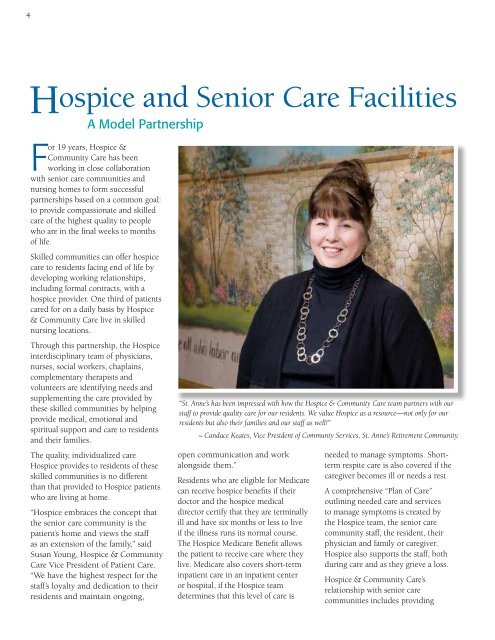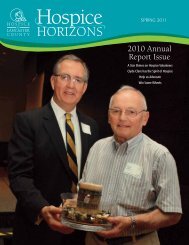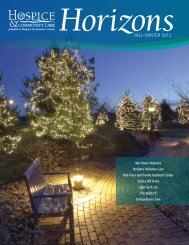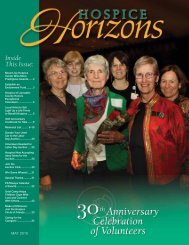Create successful ePaper yourself
Turn your PDF publications into a flip-book with our unique Google optimized e-Paper software.
4<br />
<strong>Hospice</strong> and Senior Care Facilities<br />
A Model Partnership<br />
For 19 years, <strong>Hospice</strong> &<br />
Community Care has been<br />
working in close collaboration<br />
with senior care communities and<br />
nursing homes to form successful<br />
partnerships based on a common goal:<br />
to provide compassionate and skilled<br />
care of the highest quality to people<br />
who are in the final weeks to months<br />
of life.<br />
Skilled communities can offer hospice<br />
care to residents facing end of life by<br />
developing working relationships,<br />
including formal contracts, with a<br />
hospice provider. One third of patients<br />
cared for on a daily basis by <strong>Hospice</strong><br />
& Community Care live in skilled<br />
nursing locations.<br />
Through this partnership, the <strong>Hospice</strong><br />
interdisciplinary team of physicians,<br />
nurses, social workers, chaplains,<br />
complementary therapists and<br />
volunteers are identifying needs and<br />
supplementing the care provided by<br />
these skilled communities by helping<br />
provide medical, emotional and<br />
spiritual support and care to residents<br />
and their families.<br />
The quality, individualized care<br />
<strong>Hospice</strong> provides to residents of these<br />
skilled communities is no different<br />
than that provided to <strong>Hospice</strong> patients<br />
who are living at home.<br />
“<strong>Hospice</strong> embraces the concept that<br />
the senior care community is the<br />
patient’s home and views the staff<br />
as an extension of the family,” said<br />
Susan Young, <strong>Hospice</strong> & Community<br />
Care Vice President of Patient Care.<br />
“We have the highest respect for the<br />
staff’s loyalty and dedication to their<br />
residents and maintain ongoing,<br />
“St. Anne’s has been impressed with how the <strong>Hospice</strong> & Community Care team partners with our<br />
staff to provide quality care for our residents. We value <strong>Hospice</strong> as a resource—not only for our<br />
residents but also their families and our staff as well!”<br />
~ Candace Keates, Vice President of Communty Services, St. Anne’s Retirement Community.<br />
open communication and work<br />
alongside them.”<br />
Residents who are eligible for Medicare<br />
can receive hospice benefits if their<br />
doctor and the hospice medical<br />
director certify that they are terminally<br />
ill and have six months or less to live<br />
if the illness runs its normal course.<br />
The <strong>Hospice</strong> Medicare Benefit allows<br />
the patient to receive care where they<br />
live. Medicare also covers short-term<br />
inpatient care in an inpatient center<br />
or hospital, if the <strong>Hospice</strong> team<br />
determines that this level of care is<br />
needed to manage symptoms. Shortterm<br />
respite care is also covered if the<br />
caregiver becomes ill or needs a rest.<br />
A comprehensive “Plan of Care”<br />
outlining needed care and services<br />
to manage symptoms is created by<br />
the <strong>Hospice</strong> team, the senior care<br />
community staff, the resident, their<br />
physician and family or caregiver.<br />
<strong>Hospice</strong> also supports the staff, both<br />
during care and as they grieve a loss.<br />
<strong>Hospice</strong> & Community Care’s<br />
relationship with senior care<br />
communities includes providing







